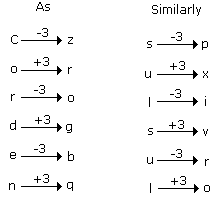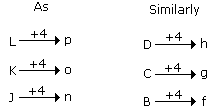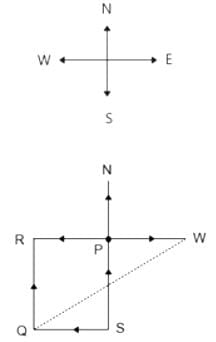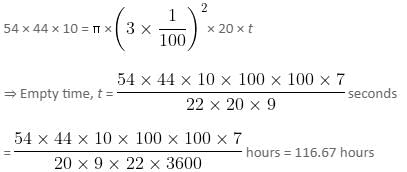CISF Head Constable Mock Test - 4 - CISF Head Constable MCQ
30 Questions MCQ Test CISF Head Constable Mock Test Series 2025 - CISF Head Constable Mock Test - 4
Read the passage below and solve the questions based on it.
1. In a joint family of seven persons A, B, C, D, E, F and G, there are two married couples.
2. G is a housewife and her husband is a lawyer. ‘C’ is the wife of ‘B’, ‘A’ is an engineer and is granddaughter of ‘G’. ‘D’ is the father-in-law of ‘C’, a doctor, and father of ‘E’, a Professor. ‘F’ is A’s brother and B’s son.
Who is a lawyer?
2. G is a housewife and her husband is a lawyer. ‘C’ is the wife of ‘B’, ‘A’ is an engineer and is granddaughter of ‘G’. ‘D’ is the father-in-law of ‘C’, a doctor, and father of ‘E’, a Professor. ‘F’ is A’s brother and B’s son.
In this following question, four words have been given, out of which three are alike in some manner and the fourth one is different. Choose out the odd one out.
Directions to Solve
In each of the following questions find out the alternative which will replace the question mark.
Question -
Corden : zrogbq :: ? : pxivro
Directions to Solve
In each of the following questions find out the alternative which will replace the question mark.
Question -
LKJ : pon :: ? : hgf
Two matrices are shown in the figure below. Their rows and columns are labelled as (0,1,2,3,4) and (5,6,7,8,9) in the manner shown. Find the correct row-column pairs out of the following matrices that decode to the word - CAGE
Direction: In each question below is given a statement followed by two conclusions numbered I and II. You have to assume everything in the statement to be true, then consider the two conclusions together and decide which of them logically follows beyond a reasonable doubt from the information given in the statement.
Statements: The manager humiliated Sachin in the presence of his colleagues.
Conclusions:
- The manager did not like Sachin.
- Sachin was not popular with his colleagues.
Direction : Study the following question carefully and choose the right answer.
Q: If ‘COUNSEL’ is to ‘BITIRAK’ so also ‘GUIDANCE’ is to
Directions: Study the following information carefully and answer the questions given below:
Point N is 15 m to the north of P and W is 20m to the east of point P, which is to the north S. R is to the west of P and 15m to the north of Q, which is 18m to the west of S.
Q. Point W is in which direction with respect to point Q?
The average price of a share is the average of 5 readings taken at regular intervals in a day. The index price is taken by a weighted arithmetic average price of a class A and class B stock. The respective weights are 1.1 and 0.9 for the two kinds of stocks. If the five readings of a class A stock were 19, 26, 31, 35, 39 and for a class B stock the readings were 7, 8, 17, 20, 23 then what was the index price that day?
What is the rate of simple interest for the first 4 years if the sum of Rs. 360 becomes Rs. 540 in 9 years and the rate of interest for the last 5 years is 6%?
Vinod makes a deposit of Rs. 100,000 in Syndicate Bank for a period of 2 years. If the rate of interest be 12% per annum compounded half-yearly, what amount will he get after 2 years?
Find the last number which when divided by 6, 8, 15 and 30 leaves remainder 2, 4, 11 and 26 respectively?
Vijay bought some pens for Rs. 540. He lost 2 pens on his way back to the shop. Then, he sold the rest of the pens at Rs. 6 more (per pen) than what he paid for them. On the whole transaction, Vijay gained 10% on his outlay. How many pens did Vijay buy?
A rectangular reservoir has dimensions 54 meters × 44 meters × 10 meters. An outlet pipe of circular cross-section has a radius of 3 centimeters and the water runs through the pipe at a rate of 20 meters/second. What is the time taken by the outlet pipe to empty the reservoir full of water?
Out of the four sectors given, how many sectors showed a consistent trend(increase or decrease) in percentage in the allocation between the fourth plan and the seventh plan
Find out the Synonym of the following word:
ADVERSITY
Read the each sentence to find out whether there is any grammatical error in it. The error, if any will be in one part of the sentence. The letter of that part is the answer. If there is no error, the answer is 'D'. (Ignore the errors of punctuation, if any).
Read the each sentence to find out whether there is any grammatical error in it. The error, if any will be in one part of the sentence. The letter of that part is the answer. If there is no error, the answer is 'D'. (Ignore the errors of punctuation, if any).
Directions: Read the passage and answer the questions that follow:
Development is about expanding the capabilities of the disadvantaged, thereby improving their overall quality of life. Based on this understanding, Maharashtra, one of India’s richest States, is a classic case of a lack of development which is seen in its unacceptably high level of malnutrition among children in the tribal belts. While the State’s per capita income has doubled since 2004, its nutritional status has not made commensurate progress.
Poor nutrition security disproportionately affects the poorest segment of the population. According to NFHS 2015-16, every second tribal child suffers from growth restricting malnutrition due to chronic hunger. In 2005, child malnutrition claimed as many as 718 lives in Maharashtra’s Palghar district alone. Even after a decade of double digit economic growth (2004-05 to 2014-15), Palghar’s malnutrition status has barely improved.
In September 2016, the National Human Rights Commission issued notice to the Maharashtra government over reports of 600 children dying due to malnutrition in Palghar. The government responded, promising to properly implement schemes such as Jaccha Baccha and Integrated Child Development Services to check malnutrition. Our independent survey conducted in Vikramgad block of the district last year found that 57%, 21% and 53% of children in this block were stunted, wasted and underweight, respectively; 27% were severely stunted. Our data challenges what Maharashtra’s Women and Child Development Minister said in the Legislative Council in March — that “malnutrition in Palghar had come down in the past few months, owing to various interventions made by the government.”
Stunting is caused by an insufficient intake of macro- and micro-nutrients. It is generally accepted that recovery from growth retardation after two years is only possible if the affected child is put on a diet that is adequate in nutrient requirements. A critical aspect of nutrient adequacy is diet diversity, calculated by different groupings of foods consumed with the reference period ranging from one to 15 days. We calculated a 24-hour dietary diversity score by counting the number of food groups the child received in the last 24 hours. The eight food groups include: cereals, roots and tubers; legumes and nuts; dairy products; flesh foods; eggs; fish; dark green leafy vegetables; and other fruits and vegetables.
In most households it was rice and dal which was cooked most often and eaten thrice a day. These were even served at teatime to the children if they felt hungry. There was no milk, milk product or fruit in their daily diets. Even the adults drank black tea as milk was unaffordable. Only 17% of the children achieved a minimum level of diet diversity — they received four or more of the eight food groups. This low dietary diversity is a proxy indicator for the household’s food security too as the children ate the same food cooked for adult members.
Q. As per the passage, which of the following is/are needed for an adequate meal?
I. Macro and micro nutrients
II. Multiple food groups
III. High level of Intermittent fasting
Directions: Read the passage and answer the questions that follow:
Development is about expanding the capabilities of the disadvantaged, thereby improving their overall quality of life. Based on this understanding, Maharashtra, one of India’s richest States, is a classic case of a lack of development which is seen in its unacceptably high level of malnutrition among children in the tribal belts. While the State’s per capita income has doubled since 2004, its nutritional status has not made commensurate progress.
Poor nutrition security disproportionately affects the poorest segment of the population. According to NFHS 2015-16, every second tribal child suffers from growth restricting malnutrition due to chronic hunger. In 2005, child malnutrition claimed as many as 718 lives in Maharashtra’s Palghar district alone. Even after a decade of double digit economic growth (2004-05 to 2014-15), Palghar’s malnutrition status has barely improved.
In September 2016, the National Human Rights Commission issued notice to the Maharashtra government over reports of 600 children dying due to malnutrition in Palghar. The government responded, promising to properly implement schemes such as Jaccha Baccha and Integrated Child Development Services to check malnutrition. Our independent survey conducted in Vikramgad block of the district last year found that 57%, 21% and 53% of children in this block were stunted, wasted and underweight, respectively; 27% were severely stunted. Our data challenges what Maharashtra’s Women and Child Development Minister said in the Legislative Council in March — that “malnutrition in Palghar had come down in the past few months, owing to various interventions made by the government.”
Stunting is caused by an insufficient intake of macro- and micro-nutrients. It is generally accepted that recovery from growth retardation after two years is only possible if the affected child is put on a diet that is adequate in nutrient requirements. A critical aspect of nutrient adequacy is diet diversity, calculated by different groupings of foods consumed with the reference period ranging from one to 15 days. We calculated a 24-hour dietary diversity score by counting the number of food groups the child received in the last 24 hours. The eight food groups include: cereals, roots and tubers; legumes and nuts; dairy products; flesh foods; eggs; fish; dark green leafy vegetables; and other fruits and vegetables.
In most households it was rice and dal which was cooked most often and eaten thrice a day. These were even served at teatime to the children if they felt hungry. There was no milk, milk product or fruit in their daily diets. Even the adults drank black tea as milk was unaffordable. Only 17% of the children achieved a minimum level of diet diversity — they received four or more of the eight food groups. This low dietary diversity is a proxy indicator for the household’s food security too as the children ate the same food cooked for adult members.
Q. What could possibly be a/some possible reason/s for such extreme food insecurity among tribal households as has been shown in the passage?
I. Loss of their traditional dependence on forest livelihood.
II. Weak implementation of public nutrition schemes.
III. A worsening agriculture situation.
Directions: Read the passage and answer the questions that follow:
Development is about expanding the capabilities of the disadvantaged, thereby improving their overall quality of life. Based on this understanding, Maharashtra, one of India’s richest States, is a classic case of a lack of development which is seen in its unacceptably high level of malnutrition among children in the tribal belts. While the State’s per capita income has doubled since 2004, its nutritional status has not made commensurate progress.
Poor nutrition security disproportionately affects the poorest segment of the population. According to NFHS 2015-16, every second tribal child suffers from growth restricting malnutrition due to chronic hunger. In 2005, child malnutrition claimed as many as 718 lives in Maharashtra’s Palghar district alone. Even after a decade of double digit economic growth (2004-05 to 2014-15), Palghar’s malnutrition status has barely improved.
In September 2016, the National Human Rights Commission issued notice to the Maharashtra government over reports of 600 children dying due to malnutrition in Palghar. The government responded, promising to properly implement schemes such as Jaccha Baccha and Integrated Child Development Services to check malnutrition. Our independent survey conducted in Vikramgad block of the district last year found that 57%, 21% and 53% of children in this block were stunted, wasted and underweight, respectively; 27% were severely stunted. Our data challenges what Maharashtra’s Women and Child Development Minister said in the Legislative Council in March — that “malnutrition in Palghar had come down in the past few months, owing to various interventions made by the government.”
Stunting is caused by an insufficient intake of macro- and micro-nutrients. It is generally accepted that recovery from growth retardation after two years is only possible if the affected child is put on a diet that is adequate in nutrient requirements. A critical aspect of nutrient adequacy is diet diversity, calculated by different groupings of foods consumed with the reference period ranging from one to 15 days. We calculated a 24-hour dietary diversity score by counting the number of food groups the child received in the last 24 hours. The eight food groups include: cereals, roots and tubers; legumes and nuts; dairy products; flesh foods; eggs; fish; dark green leafy vegetables; and other fruits and vegetables.
In most households it was rice and dal which was cooked most often and eaten thrice a day. These were even served at teatime to the children if they felt hungry. There was no milk, milk product or fruit in their daily diets. Even the adults drank black tea as milk was unaffordable. Only 17% of the children achieved a minimum level of diet diversity — they received four or more of the eight food groups. This low dietary diversity is a proxy indicator for the household’s food security too as the children ate the same food cooked for adult members.
Q. Which of the following is/are true as per the passage?
I. India’s situation is worse than in some of the world’s poorest countries — Bangladesh, Afghanistan or Mozambique.
II. Development is more than just economic growth.
III. On an average, the nutrition expenditure as a percentage of the Budget has drastically declined from 1.68% in 2012-13 to 0.94% in 2018-19.
Directions: Out of the given alternatives, choose the one which can be substituted for the given words/sentence.
That which cannot be avoided:
The MLAs belong to the ruling party will elect their leader who will become the
During the Indian Freedom Struggle, why did Rowlatt Act arouse popular indignation?
During whose Governor Generalship the Maratha confederacy ended?
In the history of Indian population, which duration period is referred to as 'A great leap forward'?
With reference to 'Equalisation Levy 2.0', which of the following statements is/are correct?
1. It covers online sales of all goods and services.
2. It is applied to only non-resident companies.
3. India is the only G20 nation to have implemented such a tax.
Select the correct answer using the code given below.
Consider the following:
1. SAARC
2. ASEAN
3. G 20
4. BRICS
India entered into a complete open sky agreement with which of the given above regional groups?
Who is hosting the seventh edition of the Japan-India Maritime Exercise 2023 (JIMEX 23)?






 On simplifying, we get
On simplifying, we get
















